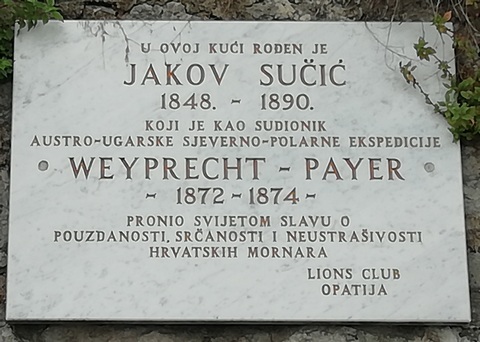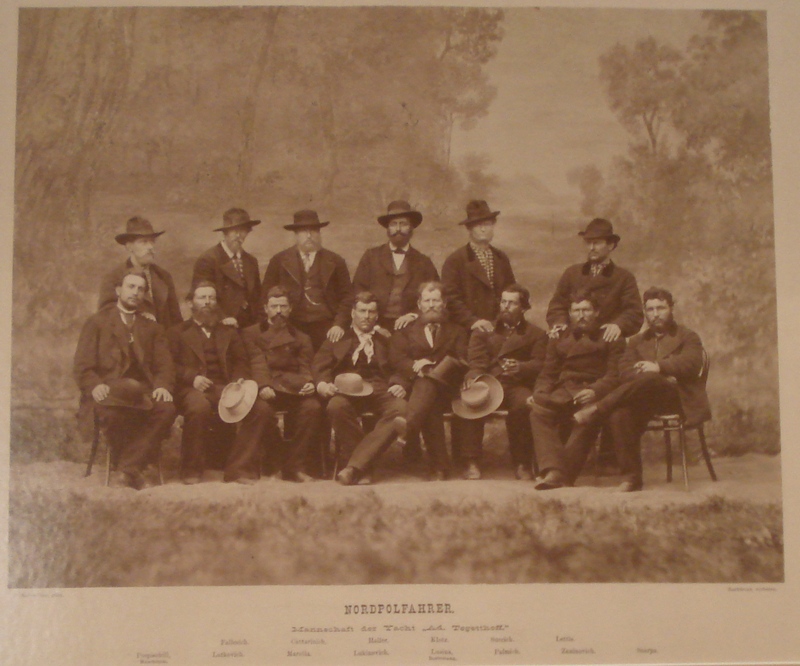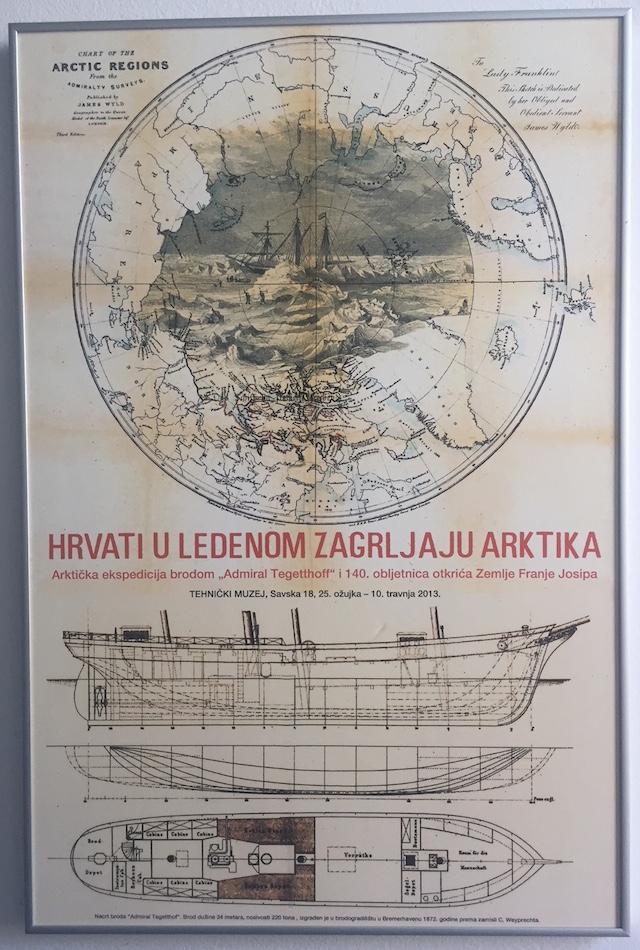Croatian mariners in the ARCTIC EXPEDITION in 1872-1874
Darko Zubrinic, Zagreb (2000)Many Arctic expeditions in the 19th century ended with shipwrecks. Probably the best known is Franklin's expedition (1845) which had tragic human losses: as many as 120 people died. Twenty expeditions were organized in order to find and save them, but in vain.
The Austrian-Hungarian state, which at that time included also Croatian coast, planned expedition to NE of Novaya Zemlya, and to find the so called North East Passage. This led to the discovery of Franz Josef Land in 1873, a collection of about 85 islands in the Arctic Ocean, now a Russian National Park called Zemlya Franca Iosifa.
The ship named Tegetthoff was built up in the German port Bremen using a special new technology, in order to endure extremely low temperatures and dangerous ice pressure (32 m long, 7 m wide, 220 tons). The crew was composed of 24 persons, members of Austrian-Hungarian marine in the Adriatic sea. It is interesting that the Croats were predominant in the crew. It was composed 9 Austrians, 1 Hungarian, 1 Moravian Czech, 1 Italian (?), and as many as 12 Croats from various parts of Croatian coast (Rijeka, Cres, Bakar, Volosko, Lovran, Plomin, Mali Losinj, Brac, Hvar). The names of these Croatian mariners are:
- Petar Lusina (from the island of Cres),
- Lovro Marolla (from Rijeka),
- Ante Vecerina (from Draga near Rijeka),
- Petar Falesic (from Bakar),
- Juraj Stiglic (from Bakar),
- Jakov Sucic (from Volosko),
- Fran Lettis (from Volosko),
- Vicko Palmic (from Lovran),
- Josip Latkovic (from Plomin),
- Ante Katarinic (from Mali Losinj),
- Ante Lukinovic (from Pucisca on the island of Brac),
- Ante Zaninovic (from Sv. Nedilja on the island of Hvar).
In his diary Julius Payer includes Ante Scarpa from Trieste into Slavonic (Croatian) group, see [Kunicic], p. 40, and according to Kunicic the Croatian crew had 13 members (see p. 2), not 12. Also every Sunday the Croats read parts of Evangel in Croatian (scavet), which belongs to glagolitic tradition, see [Kunicic] p. 38. On Christmas they sang a well known song "U se vrime godista", and remember their customs. The crew had a small library with about 400 books, half of them scientific. And a part of books was in Croatian.
For the complete list of names and other details related to this expedition, see here. There were some objections addressed to Karl Weyprecht, captain of the ship, why he chose so many Croats, instead of Tyrol Austrians. He answered that he counts on endurance, discipline and experience of Croatian mariners, and the fact that they do not drink.
Very important for success of this carefully planned and dangerous expedition was the presence of eight dogs. The expedition led to the discovery of Franz Josef's Land in the Arctic.

Memorail tablet in honour of Vicko Palmić and Weyprecht-Payer
in
the town of Lovran, Istrian peninsula, Croatia.

Vicko Palmic, Lovran, photo from an exhibition in Lovran 2012.
In 1872, when the expedition sailed off from the port of Bremen, weather condition and temperature were particularly severe. A result of ice movement was that the sailboat became wedged in the mass of ice for two years! At that time it was not possible to communicate with the rest of the world as it is today. During these two years the crew, although in extremely difficult situation, performed numerous scientific investigations. The preserved log-book testimonies about very serious and well organized everyday life and work. As the ice moved slowly northward, the mountains emerged, that they named Franz Josef's Land. It had been decided to leave the location of the ship, and carry three auxiliary saving ships on sledges, tugged with dogs and people. In dramatic 800 kilometers that they covered mostly on foot under very difficult conditions, they discovered numerous new interesting places. So today we have places like the Cape of Fiume (= the town of Rijeka, on Croatian littoral), and the Cape of Klagenfurt (a town in Austria).

Jakob (Jacobus) Sucic, Volosko

Many thanks to dr. Sanja Rukavina of the University of Rijeka, for
sending
us this photo from Volosko, where Jakov Sučić was born.
One of participants of this adventure was Eling Carlson from Norway, connoisseur of northern seas. Unfortunately, one member died due to sickness: Oton Kriz from Moravia (today in Czechia). After about two years of stay in the Arctic the ship Thegetthoff was left by the whole crew in the ocean of ice, and 23 people set off back to Europe in three small saving ships. For almost three months people and dogs had to tug boats on sledges, and then during next nine days they had to row until they finally met two russian fishing boats near Novaya Zemlya.

A part of the the North Pole Team
As stated in [Kunicic], p. 122, there is no king in the world that would be accepted with such hospitality and joy as those totally exhausted people were accepted by Russian mariners. It is very probable that Croatian mariners were able to communicate with Russians, since Croatian and Russian languages are relatively close. Among all members of the expedition only Petar Lusina (from the island of Cres) knew Russian. Besides his native Croatian, he also spoke English, French and Italian. Members of the expedition learned many news that have happened in Europe during two and a half years of their expedition. The two boats took them to Vardoe in Norway, for which Russian mariners have sacrificed four days of their fishing, plus four days for the return.

Memorial plaque in Opatija in honour of Frane Letiš, member of the team, was born in this town.
Upon successful arrival to Europe, with help of Russian and Norwegian navy, members of expedition reached Hamburg. In Vienna a glorious welcome was organised, and all of them obtained honorary citizenship in Austrian-Hungarian state. A grand "banchetto" was organized in the Croatian town of Volosko near Rijeka. The overall expenses were such that the expedition ended with +17.61 forints, which we know from a very detailed and pedantic final account.
It is interesting that experiences of this expedition were important in the preparation of Amundsen's expedition to Arctic about 30 years later.
Croatian descent of half of the crew was not even mentioned in the existing literature available in German, English, and Italian. In Croatia itself, the expedition was described by Eugen Kumicic.
It also worth mentioning that in 1882, as a part of the First International Geophysical Year, another very ambitious and successful expedition had been organized to the region of Greenland (in the part which is north of Island). Also in this case, in the crew composed of 12 half of them were Croats. Their names are
Ivan Samanic, Josip Baretincic, Anton Mikacic, Anton Lukinovic, Jakov Succic, Tomas Diminich. For the remaining names of the crew and other details see here.

Miljenko Smokvina: Nevjerojatna polarna ekspedicija 1872. - istraživački brod Tegetthoff
Ostale aktivnosti g. Miljenka Smokvine iz Rijeke
References:
- Das Tagebuch des Maschinisten Otto Krisch Österreichisch-Ungarische Nordpolexpedition von 1872 bis 1874 Hrsg.: Egon Reichhardt (Leykam Verlag 1973) [Payer & Weyprecht]
- Die Österreich-Ungarische Nordpol Expedition In den Jahren 1869-1874 Julius Payer (A.Hölder,Wien 1876 )
- FRANZ-JOSEFS-LAND -.-: ÖSTERREICHISCHE NATIONALBIBLIOTHEK: 100 Jahre Franz-Josefs-Land. Zur Erinnerung an die Entdeckungsreise der Österreichisch-Ungarischen Nordpol-Expedition 1872-1874 unter Julius von Payer und Carl Weyprecht. Katalog der Ausstellung 1973. Mit 24 Taf. Wien, o.V., 1973. Okart., g.e. XII, 128 pp.
- Austro-Hungarian North Pole Expedition 1872-74 (Franz Josef's Land)
- Petar Kunicic, Hrvati na Ledenom moru, putovanje po sjeveru s hrvatskim mornarima, po izvjescu Julija Payera (pretisak iz 1893.g.), Dom & Svijet, Zagreb, 1994. (Petar Kunicic was a teacher on the island of Vis)
- Adam Eterovich Bracanin: CROATIANS AND THE POLAR EXPEDITION OF 1872
It was Mr Miljenko Smokvina from Rijeka who noticed from the names of members of the crew that many of them are Croatian. After painstaking study that he undertook in 1990s, he discovered many new interesting details about these brave Croatian mariners.
I express my deepest gratitude to Mr Miljenko Smokvina for his kind help during the preparation of this web page, and also to Matica hrvatska for having organized very interesting lectures about history and culture of the city of Rijeka, presented by members of Matica hrvatska Rijeka in April 2000 in Zagreb.
Nikola Primorac Croatian captain of City of Ragusa craft sailing from Liverpool to New York and back in 1870
Pomorski i povijesni muzej Hrvatskog primorja u gradu Rijeci niti ne spominje Arktičku ekspediciju. Kako je to moguće?
Tomo Višković, grob na
otoku Jan Mayen na Arktiku
Back to Croatian mariners in the New World; Croatian Guilds and Collegiums